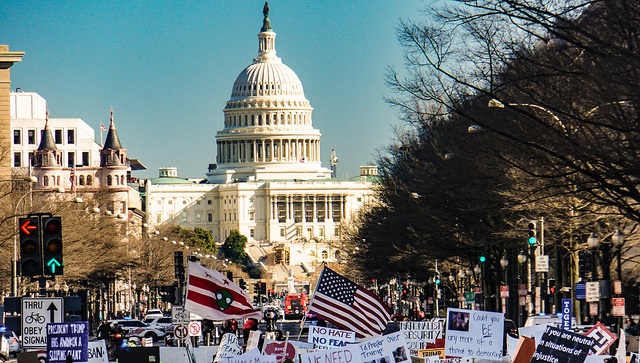
The president’s budget is a statement of principles and priorities, articulating an administration’s vision for the whole of government and a starting place for the annual appropriations process. But the Trump administration’s proposed FY19 budget, released earlier this week, reads like a nightmare for most of us.
The budget includes large increases for immigration enforcement and for the military, and sweeping cuts to education, health care, food assistance, and other valuable social programs that help millions in the U.S.
Our country deserves an alternative that protects our communities, addresses inequality, and strengthens vital public programs. As Congress works to pass a budget in the months ahead, we’ll keep you up to date on ways to take action to demand policies that reflects the real needs of our communities.
Understanding what’s in the budget is a good first step. Here are three key things you need to know about Trump’s proposal:
1. It further bloats military spending while slashing funds for diplomacy.
The U.S. already spends more on its military than the next seven countries–many of which are allies—combined. And while the deal Congress passed last week would continue to devote more than half of the nation’s discretionary budget to military spending, the president has proposed a shocking 7 percent increase to this—to a whopping 61 percent of the funds Congress appropriates annually.
The proposal would also slash funding for U.S. diplomacy, with a 41 percent cut to the State Department and non-military foreign aid—a stark comparison at only 2 percent of the proposed budget.
2. It doubles down on draconian policies toward immigrants.
Trump’s budget proposal would further expand inhumane immigrant detention, adding funding for Immigration and Customs Enforcement (ICE) to lock up 8,000 more people each night—at a time when current detention levels top 39,000. The proposal would also add 2,000 more immigration agents and 750 more border patrol agents, expanding the administration’s ability to terrorize and arrest immigrants and tear apart families.
The budget also includes $1.6 billion for the president's wasteful and deadly border wall, which will cut through communities, inflict environmental damage, and lead to more migrant deaths.
3. It slashes funds for human needs and make benefits more difficult to access.
The Supplemental Nutrition Assistance Program (SNAP), also known as food stamps, helps millions of Americans put food on the table every year. Trump’s proposal would strip 22 percent of funding from the program, when compared to the program’s total cost last year. It also proposes altering the program to take away beneficiaries’ freedom to choose their own groceries, sending a box of commodity food instead.
Trump’s proposal would cut access to affordable housing as well, with a 14 percent reduction in funding for the Department of Housing and Urban Development (HUD). Section 8 vouchers would be cut, resulting in more than 250,000 low-income families losing their housing assistance. Funding for capital repairs in public housing would be eliminated entirely for the year. Community development blocks grants, which currently help fund disaster recovery, homeownership for low-income residents, and neighborhood redevelopment, would also be eliminated.
Health care would also be impacted by the budget proposal. Overall, the Trump budget would cut federal funding for Medicaid by $250 billion over the next 10 years, with provisions modeled on a Senate Republican proposal that failed last fall to repeal the Affordable Care Act. Those cuts would cause millions of Americans to lose their health insurance, and many more would see their Medicaid benefits reduced.
Stay up to date
Policy proposals that mirror this budget are moving now in Congress, paving the way for draconian shifts sought on multiple fronts. For example, the immigration funding levels in the proposed budget mirror the policy changes sought in the White House immigration proposal released in January. We must continue to speak out against these cruel shifts in our nation’s priorities, and call for policies that meet the real needs of our communities.
Get updates on how you can take action on these issues in the months ahead.
• Sign up for our action alerts.
• Follow us on Facebook and Twitter.